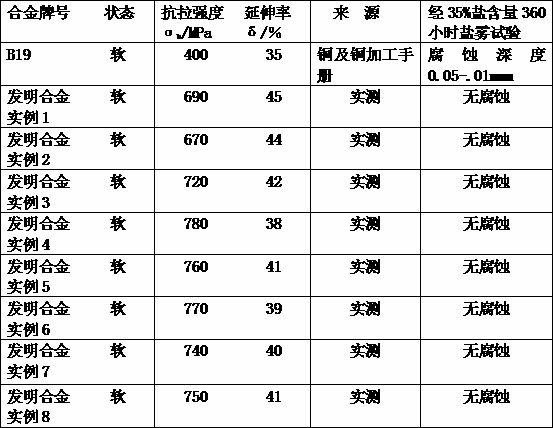High-strength and high-corrosion-resistance cupronickel alloy and manufacturing method thereof
A corrosive, high-strength technology, applied in the field of copper-nickel alloys, can solve problems such as failure to see, and achieve the effects of low processing cost, good workability and wide application
- Summary
- Abstract
- Description
- Claims
- Application Information
AI Technical Summary
Problems solved by technology
Method used
Image
Examples
Embodiment 1
[0019] (1) Prepare alloy materials with electrolytic copper, electrolytic nickel, sponge zirconium, and silicon as raw materials. The design masses of each group are electrolytic copper 10.7 kg, electrolytic nickel 8.9 kg, sponge zirconium 0.015 kg, and metal silicon powder 0.1 kg (packed in steps into a 25 kg vacuum induction furnace). The operation procedure is as follows: put nickel + copper + silicon into the magnesia crucible, put zirconium sponge into the feeding tank → vacuumize → power melting (when the vacuum degree reaches 0.9 ~ 1.0Pa, adjust the power to 30-45KW) → refining 30-40 Minutes → power off until condensation and crusting → power on again for melting (power 15-25KW) → refining for 20-30 minutes, fill with argon to a vacuum of 0.08-0.09MPa, then add sponge zirconium and tilt the furnace for 3-5 times → measure temperature (1380-1420°C) → electrified casting, mold forming, cooling for 10-20 minutes to take ingots → sampling.
[0020] (2) After face milling, ...
Embodiment 2
[0030] (1) Prepare alloy materials with electrolytic copper, electrolytic nickel, sponge zirconium, and silicon as raw materials. The design weight of each group is 10.9 kg electrolytic copper, 8.7 kg electrolytic nickel, 0.02 kg sponge zirconium, and 0.13 kg metal silicon powder (step by step) into a 25 kg vacuum induction furnace). The operation procedure is as follows: put nickel + copper + silicon into the magnesia crucible, put zirconium sponge into the feeding tank → vacuumize → power melting (when the vacuum degree reaches 0.9 ~ 1.0Pa, adjust the power to 30-45KW) → refining 30-40 Minutes → power off until condensation and crusting → power on again for melting (power 15-25KW) → refining for 20-30 minutes, fill with argon to a vacuum of 0.08-0.09MPa, then add sponge zirconium and tilt the furnace for 3-5 times → measure temperature (1380-1420°C) → electrified casting, mold forming, cooling for 10-20 minutes to take ingots → sampling.
[0031] (2) After face milling, the...
Embodiment 3
[0033] (1) Prepare alloy materials with electrolytic copper, electrolytic nickel, sponge zirconium, and silicon as raw materials. The design masses of each group are respectively 11 kg of electrolytic copper, 8.6 kg of electrolytic nickel, 0.025 kg of sponge zirconium, and 0.15 kg of metal silicon powder (packed in steps into a 25 kg vacuum induction furnace). The operation procedure is as follows: put nickel + copper + silicon into the magnesia crucible, put zirconium sponge into the feeding tank → vacuumize → power melting (when the vacuum degree reaches 0.9 ~ 1.0Pa, adjust the power to 30-45KW) → refining 30-40 Minutes → power off until condensation and crusting → power on again for melting (power 15-25KW) → refining for 20-30 minutes, fill with argon to a vacuum of 0.08-0.09MPa, then add sponge zirconium and tilt the furnace for 3-5 times → measure temperature (1380-1420°C) → electrified casting, mold forming, cooling for 10-20 minutes to take ingots → sampling.
[0034] ...
PUM
 Login to View More
Login to View More Abstract
Description
Claims
Application Information
 Login to View More
Login to View More - R&D
- Intellectual Property
- Life Sciences
- Materials
- Tech Scout
- Unparalleled Data Quality
- Higher Quality Content
- 60% Fewer Hallucinations
Browse by: Latest US Patents, China's latest patents, Technical Efficacy Thesaurus, Application Domain, Technology Topic, Popular Technical Reports.
© 2025 PatSnap. All rights reserved.Legal|Privacy policy|Modern Slavery Act Transparency Statement|Sitemap|About US| Contact US: help@patsnap.com

